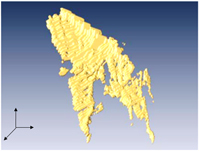Crossref Citations
This article has been cited by the following publications. This list is generated based on data provided by
Crossref.
Göken, Mathias
Eggeler, Gunther
Zhu, Yuntian
and
Lu, Lei
2017.
Introduction.
Journal of Materials Research,
Vol. 32,
Issue. 23,
p.
4273.
Göken, Mathias
Eggeler, Gunther
Zhu, Yuntian
and
Lu, Lei
2017.
Introduction.
Journal of Materials Research,
Vol. 32,
Issue. 24,
p.
4463.
Mazánová, V.
and
Polák, J.
2018.
Initiation and growth of short fatigue cracks in austenitic Sanicro 25 steel.
Fatigue & Fracture of Engineering Materials & Structures,
Vol. 41,
Issue. 7,
p.
1529.
Polák, Jaroslav
Mazánová, Veronika
Petráš, Roman
Heczko, Milan
and
Hénaff, G.
2018.
Early damage and fatigue crack initiation at ambient and elevated temperatures in heat resistant austenitic steel.
MATEC Web of Conferences,
Vol. 165,
Issue. ,
p.
04008.
Polák, Jaroslav
2019.
TMS 2019 148th Annual Meeting & Exhibition Supplemental Proceedings.
p.
1125.
Patala, Srikanth
2019.
Understanding grain boundaries – The role of crystallography, structural descriptors and machine learning.
Computational Materials Science,
Vol. 162,
Issue. ,
p.
281.
Goto, M.
Yamamoto, T.
Han, S.Z.
Lim, S.H.
Kim, S.
Ahn, J.-H.
Lee, S.J.
Yakushiji, T.
and
Lee, J.
2020.
Crack initiation mechanism in ultrafine-grained copper fabricated by severe plastic deformation in the high-cycle fatigue regime.
Materials Science and Engineering: A,
Vol. 788,
Issue. ,
p.
139569.
Lavenstein, Steven
Gu, Yejun
Madisetti, Dylan
and
El-Awady, Jaafar A.
2020.
The heterogeneity of persistent slip band nucleation and evolution in metals at the micrometer scale.
Science,
Vol. 370,
Issue. 6513,
Rafael Velayarce, Jorge
and
Motz, Christian
2020.
Effect of Sample Size and Crystal Orientation on the Fatigue Behaviour of Single Crystalline Microbeams.
Materials,
Vol. 13,
Issue. 3,
p.
741.
Babinský, T.
Kuběna, I.
Šulák, I.
Kruml, T.
Tobiáš, J.
and
Polák, J.
2021.
Surface relief evolution and fatigue crack initiation in René 41 superalloy cycled at room temperature.
Materials Science and Engineering: A,
Vol. 819,
Issue. ,
p.
141520.
Bai, Yaping
Li, Meng
Cheng, Chao
Li, Jianping
Guo, Yongchun
and
Yang, Zhong
2021.
Study on Microstructure and In Situ Tensile Deformation Behavior of Fe-25Mn-xAl-8Ni-C Alloy Prepared by Vacuum Arc Melting.
Metals,
Vol. 11,
Issue. 5,
p.
814.
Li, Hui
Chen, Pengxu
Wang, Hang
Luo, Xue
and
Zhang, Yuqing
2022.
Pseudo energy-based crack initiation criterion for asphalt-filler composite system under a fatigue shear load.
Theoretical and Applied Fracture Mechanics,
Vol. 119,
Issue. ,
p.
103333.
Cota Araujo, Mahira A.
Olive, Jean-Marc
Pecastaings, Gilles
Addad, Ahmed
Bouquerel, Jérémie
and
Vogt, Jean-Bernard
2023.
Compelling Evidence for the Role of Retained Austenite in the Formation of Low Cycle Fatigue Extrusions in a 9Ni Steel.
Metals,
Vol. 13,
Issue. 3,
p.
546.
Gomez, A.
Banis, A.
Avella, M.
Molina-Aldareguia, J.M.
Petrov, R.H.
Dutta, A.
and
Sabirov, I.
2024.
The effect of κ-carbides on high cycle fatigue behavior of a Fe-Mn-Al-C lightweight steel.
International Journal of Fatigue,
Vol. 184,
Issue. ,
p.
108306.
Panahi, Sarah
Roshan, Ibrahim
Diakina, Ekaterina
and
Javid, Reza
2024.
Effect of strain path during repeated rolling on microstructure, grain refinement, and mechanical properties of Copper/Brass multilayered composites.
Materials Today Communications,
Vol. 40,
Issue. ,
p.
110080.
Chen, Honglei
Luo, Xuemei
Zhang, Mingyuan
Wen, Ming
Zhu, Xiaofei
and
Zhang, Guangping
2024.
More severe surface relief but stronger fatigue resistance at small scales: Vacancy-assisted fatigue damage mechanism.
Acta Materialia,
Vol. 274,
Issue. ,
p.
120028.
Liu, Huiping
Xiao, Mingkun
Hao, Jiannan
Ma, Xinjie
Jiang, Ni
Peng, Qing
and
Ye, Chao
2025.
Micro-Defects-Related Low Cycle Fatigue Mechanical Model of the Nuclear-Grade S30408 Stainless Steel.
Nanomaterials,
Vol. 15,
Issue. 1,
p.
71.
Escobar-Moreno, I.
Nieto-Valeiras, E.
and
LLorca, J.
2025.
Slip transfer and crack initiation at grain and twin boundaries during strain-controlled fatigue of solution-hardened Ni-based alloys.
Acta Materialia,
Vol. 283,
Issue. ,
p.
120497.
Bai, Yaping
Lei, Naqing
Guo, Fan
He, Zibo
Li, Jianping
Sun, Chongfeng
and
Wang, Ping
2025.
The Mechanisms of Nano‐AlN Content in the Microstructure and Mechanical Properties of Fe–25Mn–9Al–8Ni–1C–0.2Ti Alloy.
steel research international,
